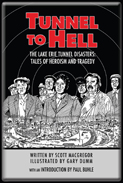
 |
Tunnel To Hell: The Lake Erie Tunnel Disasters: Tales of Heroism and Tragedy
by Scott MacGregor
illustrated by Gary Dumm
EOI Media Press Inc.
The enormity of this project is impressive in itself—a complete historical fiction novel in approximately 1,500 illustrated frames. But the depth of the history lesson and the writing eloquence are nothing short of prodigious. The book has two major plots: The tunneling under Lake Erie for fresh water, and the life of Garrett Augustus Morgan, Sr. Either story in itself could make an interesting graphic novel, but entwined, they add depth and sophistication to the novel. There is so much to learn while reading and "watching" a comic book.
The story of tunneling under Lake Erie to access clean water in the early 1900s is fairly unique and definitely intriguing. Arguably, few readers west of the Mississippi have even heard about this piece of US History. Garrett Morgan, known as Ben Beltran in this novel, isn't exactly a household name, either. But the theme of class warfare tackled in this work of fiction is not unique. Recent books, such as Deep Down Dark by Hector Tobar about the Chilean miners trapped underground in a collapsed mine comes to mind. US railroads built on the backs of Chinese immigrant laborers have been the subject of many books. In all cases, destitute humans agreed to do extremely dangerous work with the lure of money that they desperately needed. However, MacGregor writes it most directly "Gambling with life in order to remain employed was an unspoken job requirement for the sandhogs." MacGregor also composes it most eloquently, "The mere promise of a few extra dollars was enough incentive to tempt rational men down a shaft and into a tunnel where the specters of catastrophe and death, aided and abetted by city leaders' depraved indifference toward worker safety ..."
The Garret Morgan, Sr. story (aka the Ben Beltran story) is spun in skillfully. He was a dreamer, an inventor, and a brilliant visionary at the turn of the 20th century. He invented a helmet for firefighters to use to prevent smoke inhalation during the course of their duties, but most wouldn't take notice of his inventions because he was a black man. He even disguised himself as an Native American in order to seem more credible. The common plot thread is that he used his helmet to save lives in one of the Lake Erie Tunnel disasters.
Quality historical fiction requires action, adventure, and even an element of sophistication to avoid coming across like a history textbook. This is true even in graphic novel form, and MacGregor nails it: "Willy crashed his body through the flaming walls of the crib, turning his treacherous desertion into a 'fait accompli.'"
Gary Dumm's illustrations are masterful. Best known for his work on Harvey Pekar's American Splendor, Dumm writes in his dedication, "Scott MacGregor, who trusted me implicitly to collaborate artistically and lend shape and definition to his dream." Mission accomplished. In black and white frames, characters are made and described and differentiated from each other wordlessly. Each illustration comes to life so that reading this book is a bit like watching a movie. Putting historical fiction into graphic novel form is uncommon, maybe because it is so difficult. But, MacGregor’s work is a perfect example of the depth, eloquence, and continuity that is possible in a superb graphic novel.